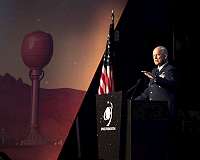Gen. John W. "Jay" Raymond, Commander, U.S. Space Command (USSPACECOM), ordered the establishment of two subordinate commands to support the warfighting efforts of the command - Combined Force Space Component Command (CFSCC), and Joint Task Force Space Defense (JTF-SD), immediately following the establishment of USSPACECOM Aug. 29, 2019.
Raymond appointed Maj. Gen. Stephen N. Whiting as CFSCC Commander, and Brig. Gen. Matthew W. Davidson as the Deputy Commander; with a mission to plan, integrate, conduct, and assess global space operations in order to deliver combat relevant space capabilities to Combatant Commanders, Coalition partners, the Joint Force, and the Nation.
Upon establishment, Whiting appointed Chief Master Sgt. John F. Bentivegna as the CFSCC Senior Enlisted Leader. Bentivegna will advise the Commander on matters influencing the health, welfare, morale and effective utilization of more than 17,000 CFSCC personnel.
CFSCC will plan and execute space operations through four distinct and geographically dispersed operations centers, including: the Combined Space Operations Center (CSpOC) at Vandenberg AFB, Calif.; Missile Warning Center (MWC) at Cheyenne Mountain Air Force Station, Colo.; Joint Overhead Persistent Infrared Center (JOPC) at Buckley AFB, Colo.; and Joint Navigation Warfare Center (JNWC) at Kirtland AFB, N.M. Additionally, the CFSCC will execute tactical control over globally dispersed Air Force, Army, and Navy space units that command satellites in every orbital regime.
"It is an honor and privilege to take command of CFSCC. We are at the dawning of a new, exciting, and challenging era for space; and CFSCC will lead USSPACECOM's efforts to better integrate space warfighting effects into the operations of terrestrial warfighters," said Whiting.
"Through our tactical units and operations centers, CFSCC will provide space capabilities such as space situational awareness, space electronic warfare, satellite communications, missile warning, nuclear detonation detection, environmental monitoring, military ISR, navigation warfare, command and control, and PNT in support of USSPACECOM and the other Combatant Commands."
As one of its primary roles, CFSCC will plan, task, direct, monitor, and assess the execution of combined and joint space operations for theater effects on behalf of the Commander of USSPACECOM in order to directly support ongoing operations in other Combatant Commands.
CFSCC will also provide support to, and receive support from, partner Coalition operations centers including the Australian Space Operations Center, Canadian Space Operations Center, and United Kingdom Space Operations Center. Additionally, CFSCC will build capacity through Coalition, Commercial, and Civil partnerships to achieve combined force objectives.
Furthermore, CFSCC will execute command and control of assigned multinational forces in support of Operation Olympic Defender (OOD), as directed by USSPACECOM.
"Through the standup of the CFSCC and multinational force agreements in OOD, we will out-pace competitor nations in developing our space capabilities, generate greater space force capacity than our competitors, and integrate highly advanced multinational space capabilities with terrestrial coalition warfighting capabilities," said Davidson.
"Last month the United Kingdom formally announced their decision to join Operation Olympic Defender, our named operation for space; and we are excited the Royal Air Force is now providing an officer to serve as the Deputy Director of the CSpOC. The U.K. is a close ally and trusted partner in space; and we are looking forward to additional allies and partners joining OOD in the near future. We are unequivocally stronger together."
On 18 July the former U.K. Defense Secretary announced the U.K. formally accepted the U.S. invitation to join OOD; and the U.K.'s intentions to send additional U.K. personnel to join other international space operators at the CSpOC at Vandenberg AFB.
Space operators from Australia, Canada, and the United Kingdom are currently stationed at Vandenberg AFB, working alongside U.S. space operators in CFSCC's CSpOC. Additionally, national liaisons from France, Germany, and the United Kingdom are stationed at Vandenberg AFB in USSPACECOM's Multinational Space Collaboration office.
"Space has become exponentially more congested, contested, and degraded domain during the past several decades. Due to emerging threats, and advances in technology, it's imperative that we partner with allies and like-minded nations to preserve access to space, and leverage coalition space capabilities to ensure warfighters down range have the systems they need to defeat the threats they're facing," said Bentivegna.
"The establishment of the CFSCC is the result of years of working alongside allies and partners in and through space. As a coalition we will continue to defend our nations' interests throughout the space domain."



